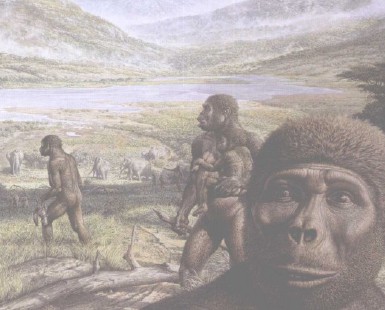Each was about ten kilometers, or six miles, away—a long way to carry an armload of stone.
兩座山都在大約10公里以外——要用手臂抱著把石頭搬到這里,實在是一段不近的距離。
Why the early Olorgesailie people went to such trouble we can only guess, of course.
當然,遠古的奧洛戛薩里人為什么要找這樣的麻煩,我們當然不得而知。
Not only did they lug hefty stones considerable distances to the lakeside, but, perhaps even more remarkably, they then organized the site.
他們不但大老遠地把笨重的石頭搬運到湖濱,而且也許更令人不可思議的是他們在這個地方的組織工作。
The Leakeys' excavations revealed that there were areas where axes were fashioned and others where blunt axes were brought to be resharpened.
利基夫婦的挖掘表明,這里有制作手斧的區(qū)域,還有把手斧磨快的區(qū)域。
Olorgesailie was, in short, a kind of factory; one that stayed in business for a million years.
一句話,從某種意義上說,奧洛戛薩里是一個工廠,一個在100萬年時間里沒有停業(yè)過的工廠。
Various replications have shown that the axes were tricky and labor-intensive objects to make—even with practice,
各種各樣的復制品表明,手斧是一種相當精巧,同時制作起來又要花費大量勞動力的工具
an axe would take hours to fashion—and yet, curiously, they were not particularly good for cutting or chopping or scraping or any of the other tasks to which they were presumably put.
即使技術熟練的人只做一把手斧。也要花費幾個小時的時間——然而,奇怪的是,對于手斧估計要派的用場,如切呀,砍呀,刮呀等等,并不十分適用。
So we are left with the position that for a million years—far, far longer than our own species has even been in existence,
因此我們認為,在100萬年時間里——在遠比我們現(xiàn)代人類存在的時間還要長的時間里,
much less engaged in continuous cooperative efforts—early people came in considerable numbers to this particular site to make extravagantly large numbers of tools that appear to have been rather curiously pointless.
在更不會連續(xù)協(xié)同工作的情況下——相當數(shù)量的早期人類來到這樣一個特定的地點,制作了數(shù)量眾多的工具,似實在有些不可思議。
And who were these people? We have no idea actually.
而這些人究竟是誰?我們實在無從知道。
We assume they were Homo erectus because there are no other known candidates,
我們假定他們是直立人,因為不知道還有其他更合適的人。
which means that at their peak—their peak —the Olorgesailie workers would have had the brains of a modern infant.
這就是說,在他們的鼎盛時期——在他們的腦袋里——奧洛戛薩里的工人們可能已經(jīng)具有類似于現(xiàn)代人嬰兒的大腦,
But there is no physical evidence on which to base a conclusion.
但是卻沒有實物證據(jù)支持這樣的結論。
Despite over sixty years of searching, no human bone has ever been found in or around the vicinity of Olorgesailie.
盡管已進行了60余年的挖掘,奧洛戛薩里及其周圍地區(qū)從未發(fā)現(xiàn)過人類化石。

However much time they spent there shaping rocks, it appears they went elsewhere to die.
不管他們花費了多少時間在那里制作石器,在他們臨死時,他們去了別的地方。
"It's all a mystery," Jillani Ngalli told me, beaming happily.
“所有這些都是一個謎。”吉拉尼.安哥里笑容可掬地對我說。
The Olorgesailie people disappeared from the scene about 200,000 years ago when the lake dried up and the Rift Valley started to become the hot and challenging place it is today.
奧洛戛薩里人大約在20萬年前消失,當時湖泊已經(jīng)干涸,大裂谷地區(qū)開始變得像今天這樣炎熱和艱苦。
But by this time their days as a species were already numbered.
到了這個時候,奧洛戛薩里人作為一個種屬存在的日子已經(jīng)屈指可數(shù)。
The world was about to get its first real master race, Homo sapiens. Things would never be the same again.
世界就要出現(xiàn)其第一個真正的主宰人種——智人。事情再也不會像從前的樣子了。



